When I reached town Villefranche-sur-Mer by train, I did not go down to the shore right away, but first I followed a path leading to the centre of the town. This path is also very good because it is located a little higher up, thus providing some very nice views from several points along the way.
 Bay in town Villefranche-sur-Mer
Bay in town Villefranche-sur-Mer
 Bay in town Villefranche-sur-Mer
Bay in town Villefranche-sur-Mer
Humans first settled here already in the prehistoric times, while the town, as a “free port,” was officially founded in 1295. It went later through a similar line of development as the rest of the places along the French Riviera, often changing its rulers. Although it certainly has its domicile population, nowadays Villefranche-sur-Mer is also the playground of the wealthy and the aristocracy, and with the development and the expansion of the territory taken up by private properties it is today considered a suburb of Nice.
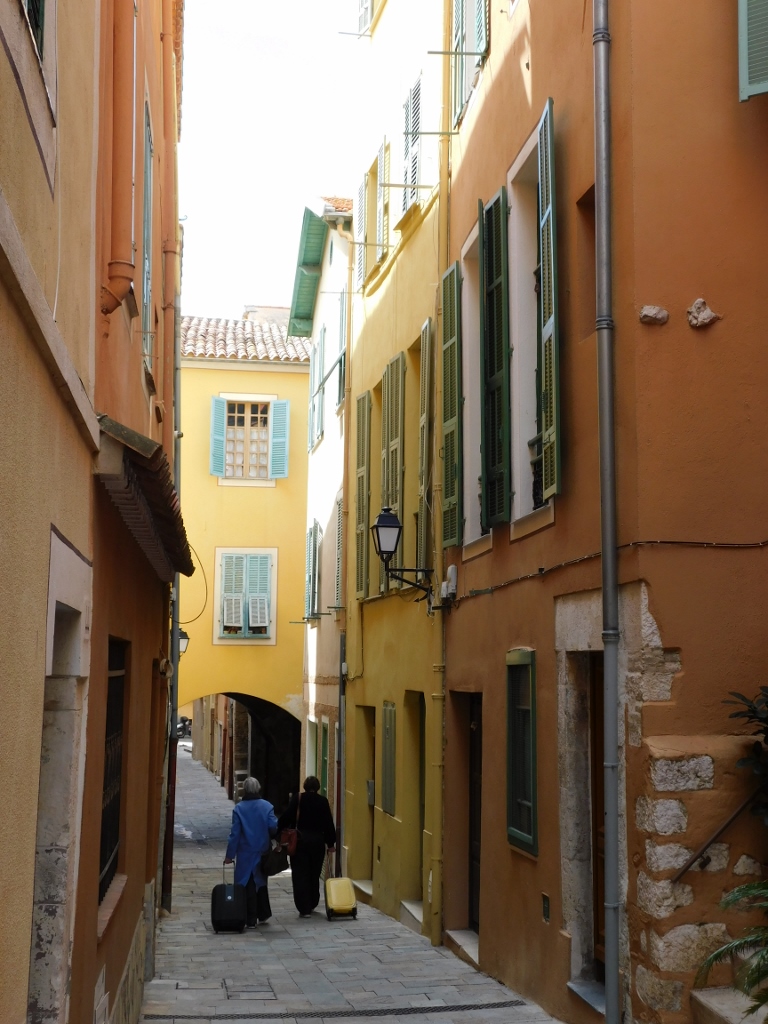 Villefranche-sur-Mer, a detail
Villefranche-sur-Mer, a detail
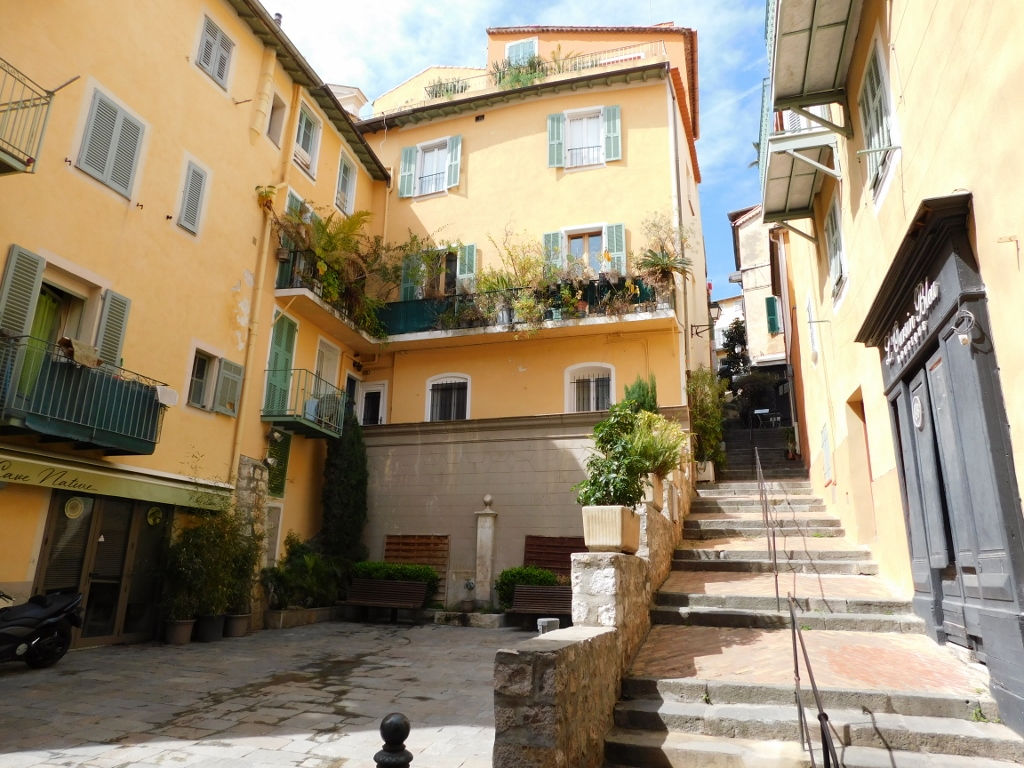 Villefranche-sur-Mer, a detail
Villefranche-sur-Mer, a detail
What makes this place different in comparison to the other ones along the French Riviera is the fact that it was created by a bay that incorporates one of the deepest natural ports in the Mediterranean Sea, which means that even large ships may dock here. Moreover, this is where the most visited cruiser port in France is.
As for the important buildings in the town, there is the Church of Saint-Michel (Église Saint-Michel de Villefranche-sur-Mer) from the 18th century. The church is surrounded by houses and narrow streets and it is not an easy object to take a photo of.
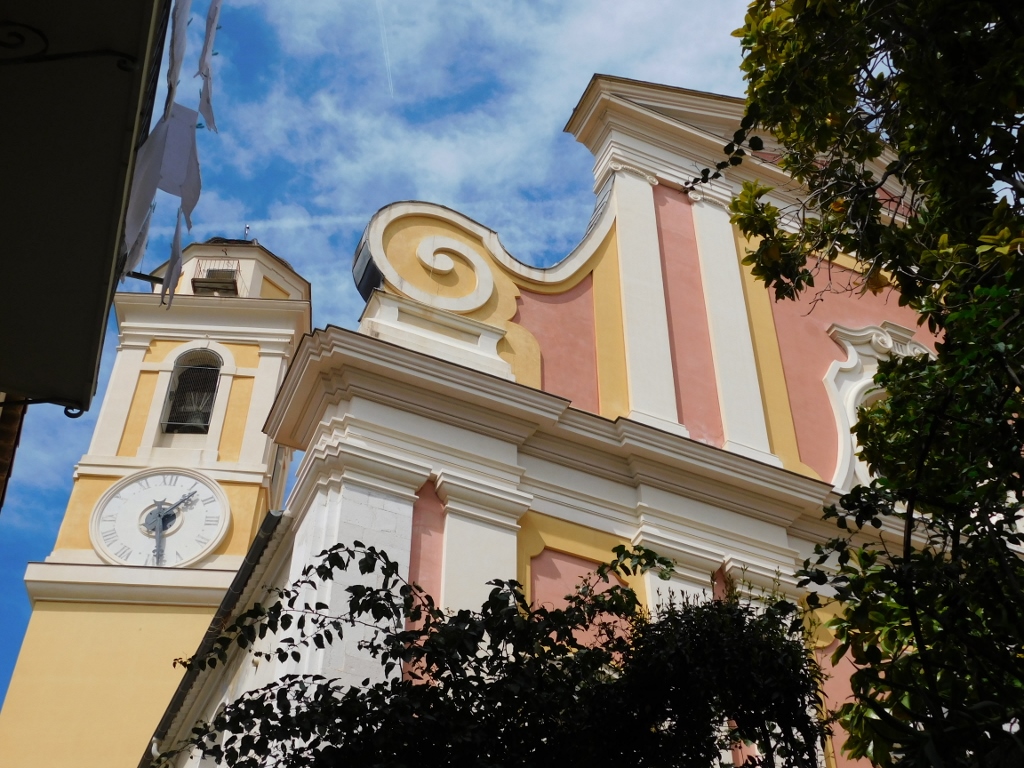 Church of Saint-Michel
Church of Saint-Michel
Perhaps the most interesting place in this lovely town is a formerly secret street. Namely, already back in 1260, a street was made here for the military purposes and it was used by the army. Over time, this function was lost and on account of the lack of space in the period from the 16th to the 18th century the inhabitants started to build their houses literally above the street. The street is called Rue Obscure which means “dark street” and it has no natural sources of light, hence the name. Nowadays it is more like a passageway or a tunnel, but it is certainly interesting.
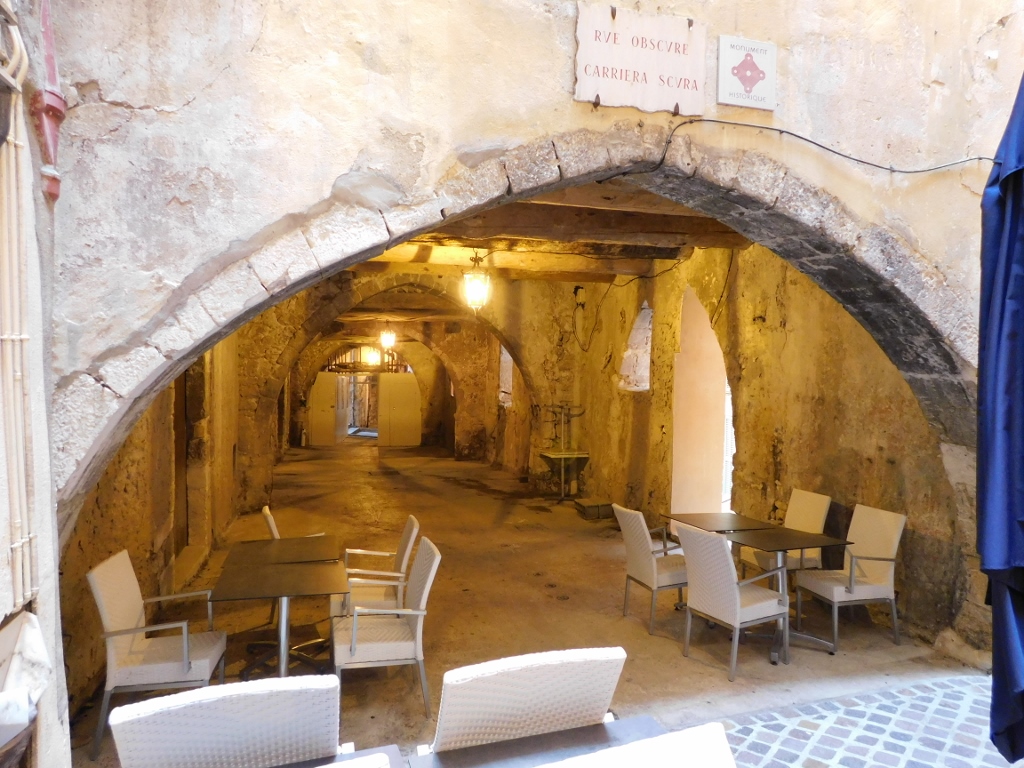 Rue Obscure
Rue Obscure
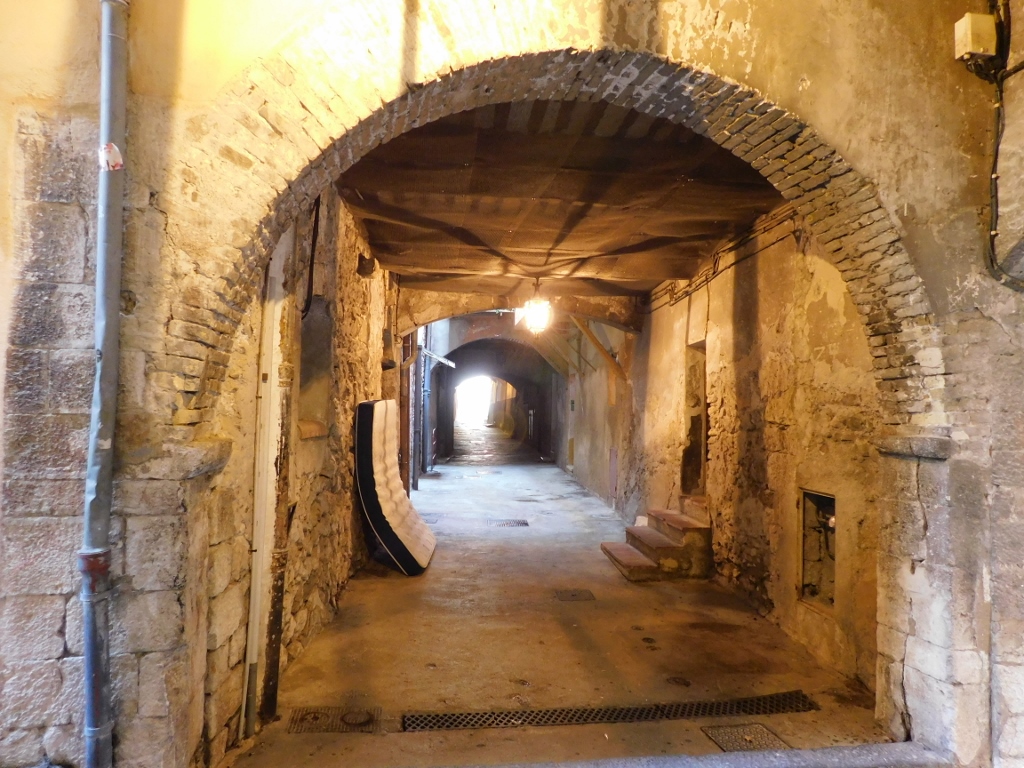 Rue Obscure
Rue Obscure
I walked here a little and then I went to a spacious plateau with restaurants where there was a lot of sunshine.
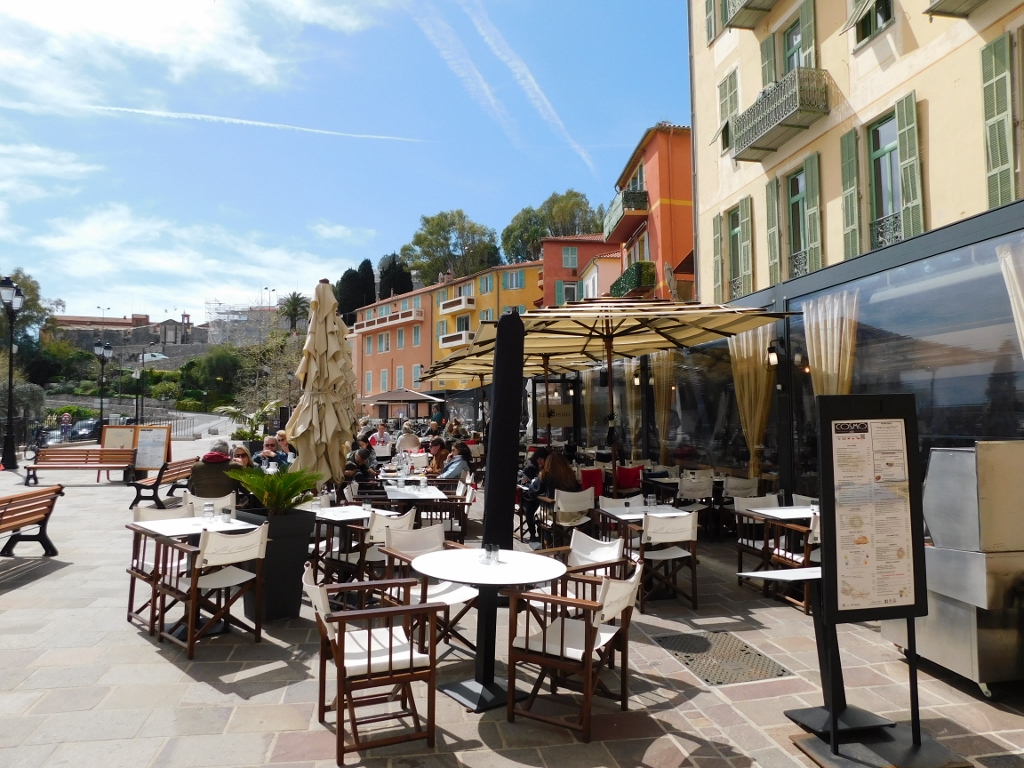 Villefranche-sur-Mer, a detail
Villefranche-sur-Mer, a detail
Taking into account that the liturgy at the Russian Orthodox Cathedral of St. Nicholas that I had attended this morning, which I have written about in the previous sequel, was quite long, I actually arrived here around lunch time. I decided to give myself a treat and that was made easy when I looked at the offered meals. I quickly made up my mind about the kind of lunch I wanted on this day.
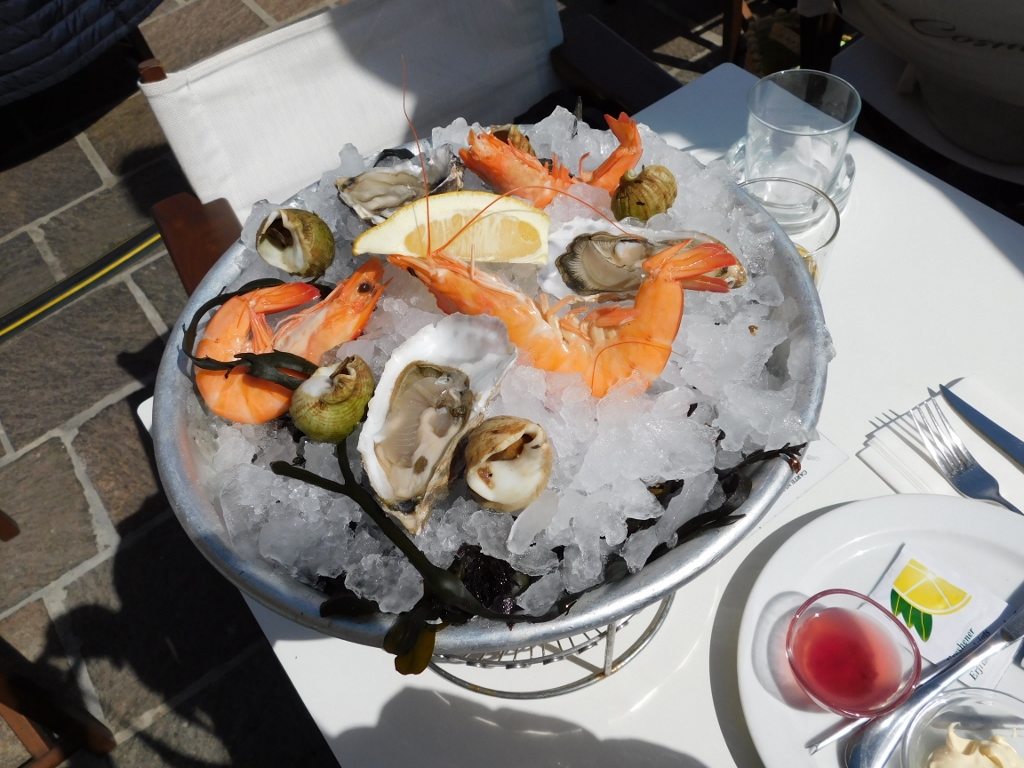 Starter in Villefranche-sur-Mer: seafood platter
Starter in Villefranche-sur-Mer: seafood platter
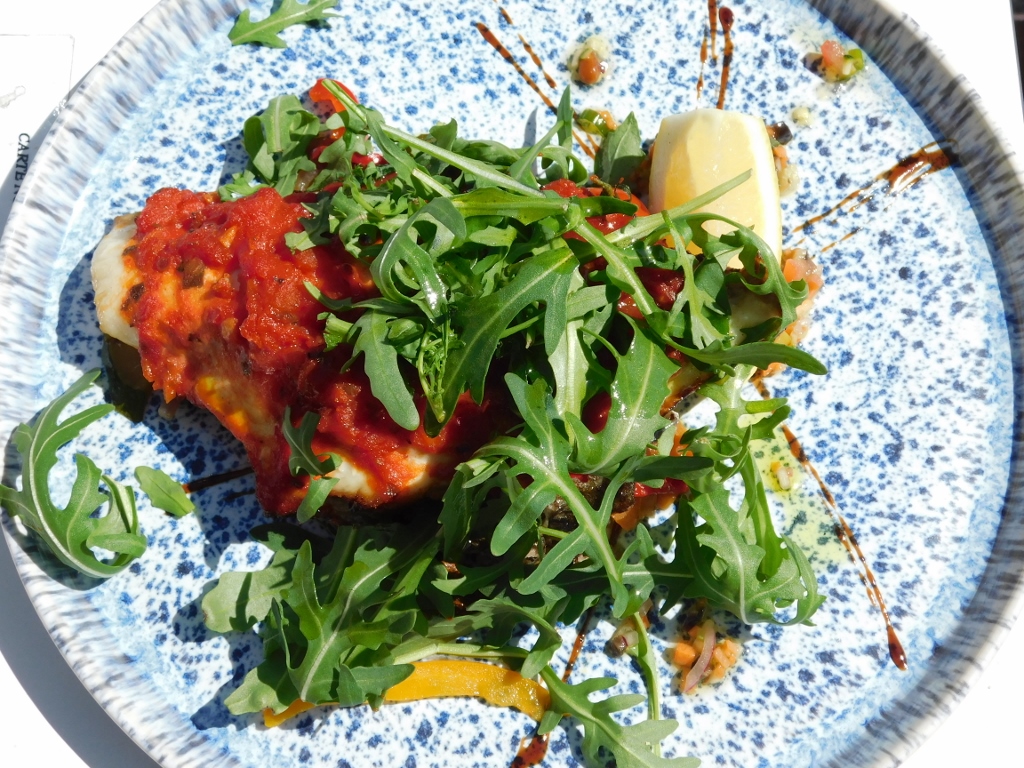 Main course in Villefranche-sur-Mer: sea bream fillet with vegetables
Main course in Villefranche-sur-Mer: sea bream fillet with vegetables
I could not resist and so I sent the photos to a few friends. One of them wrote back with some witty comments. While we were corresponding, I reported to him that a couple of days earlier my lunch consisted of crisps directly from a bag and juice directly from a bottle that I bought at a supermarket, however, as I wrote to him, such things are not taken photos of and are not sent to friends. We continued to joke about the whole matter.
Here I can also add that the sauce that went over the fish reminded me of Ratatouille, a type of a vegetable stew from Province or rather from Nice to be precise.
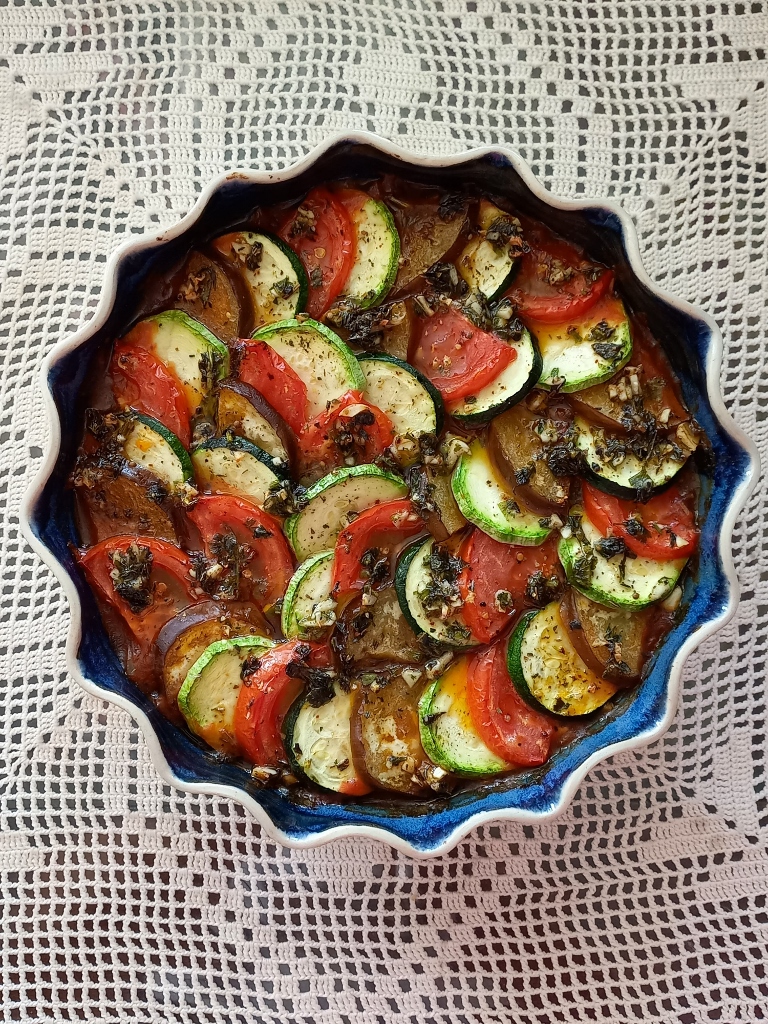 Ratatouille
Ratatouille
Here is the recipe:
RATATOUILLE
- 1 medium size onion
- 2 cloves of garlic
- 1 larger sweet pepper
- 1 tin of canned tomatoes
- basil leaves, salt and pepper
- 1 light-skin zucchini
- 1 dark-skin zucchini
- 1 tomato
- 1 thin aubergine
- 1 clove of garlic, several leaves of fresh basil, fresh thyme, parsley, salt, pepper and olive oil
Sweat the chopped onions. Add finely minced garlic, as well as finely chopped pepper. When this has cooked a little, add the tinned tomatoes and crush the tomatoes with the cooking spoon. Add the seasonings and let it cook for some 10 minutes.
When the sauce cools down a little, put it into a casserole dish. Arrange slices of the fresh vegetables over the top. Then pour over the fresh “sauce” made of the garlic, fresh aromatic leaves, salt, pepper and a few spoonfuls of olive oil.
Cover the dish either with its original lid or aluminium foil and put it into the oven at 180 degrees C for about half an hour. Remove the lid/foil and bake for another 10 minutes.
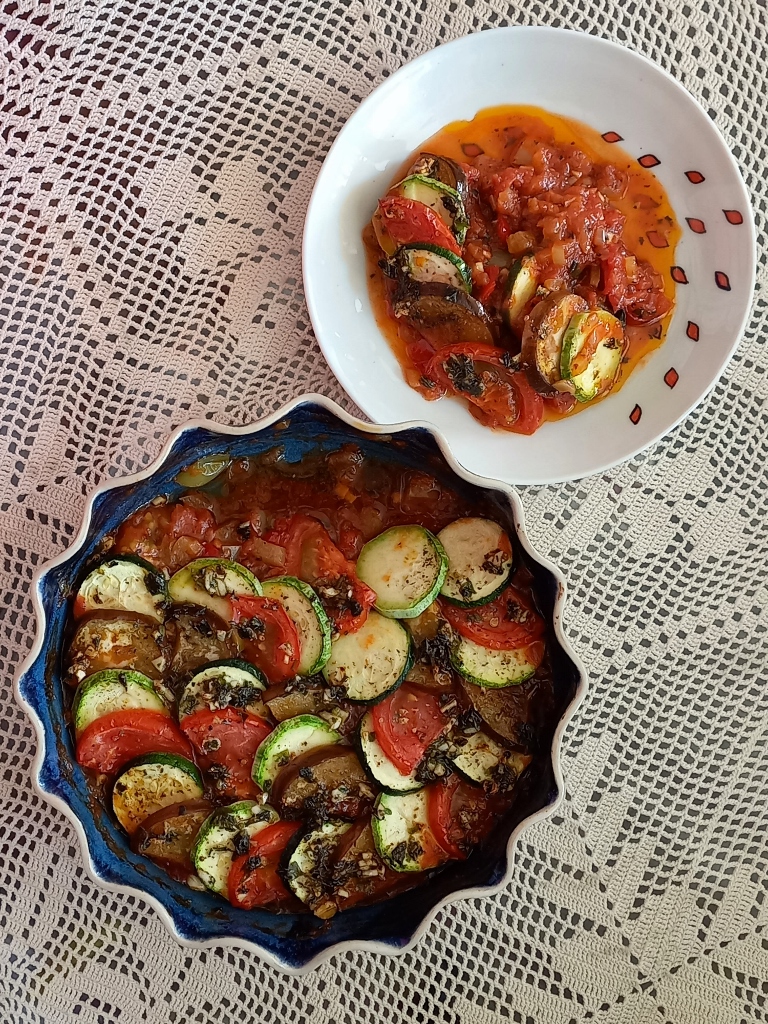 Ratatouille, prepared and served in pottery dishes I’ve made myself
Ratatouille, prepared and served in pottery dishes I’ve made myself
From the plateau at which there was the restaurant where I had my lunch, one can see another church well. This is Saint Peter’s Chapel (Chapelle Saint-Pierre).
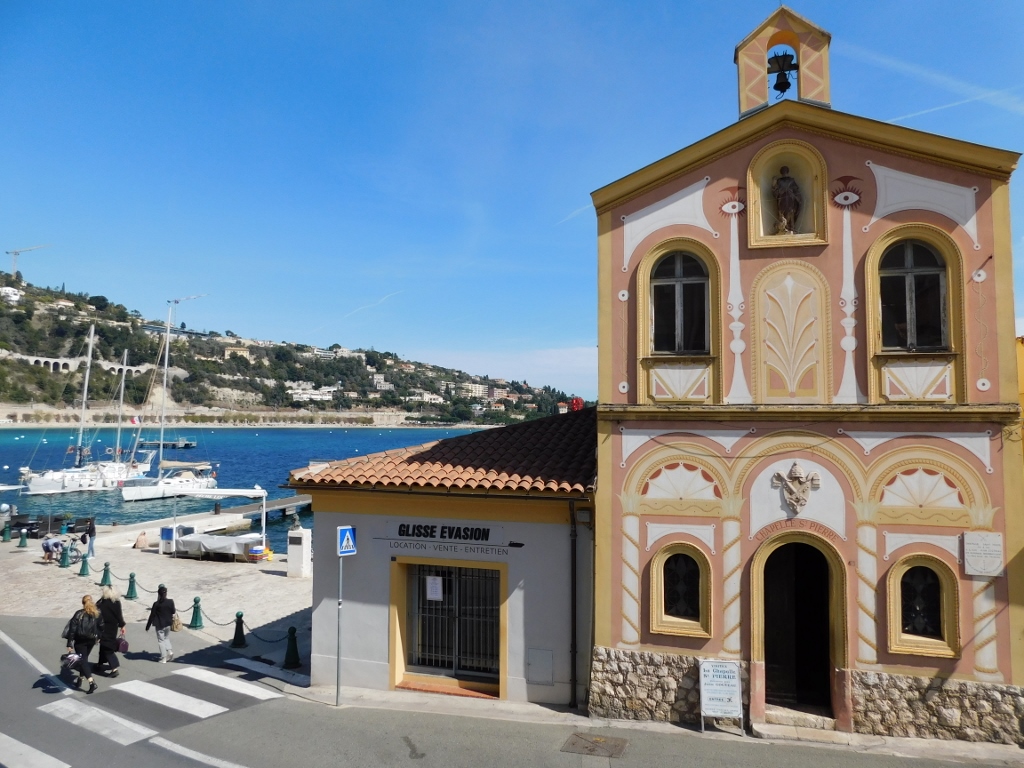 Saint Peter’s Chapel, with the bay in the background
Saint Peter’s Chapel, with the bay in the background
The chapel was built in the 16th century, but it lost this function over time and most of the 19th century and at the beginning of the 20th century it was used as a storage space for fishing equipment and nets. In 1957, the chapel was restored and there are two murals inside painted by Jean Cocteau. I must admit that I came across this piece of information only later and so, unfortunately, I did not go inside the chapel although, as it can be seen, it was open.
After the lunch, using a wide staircase, I went down from the plateau with restaurants to the street running by the shore, but first I looked back once again in order to see a part of the facade and the tower of the Church of Saint-Michel.
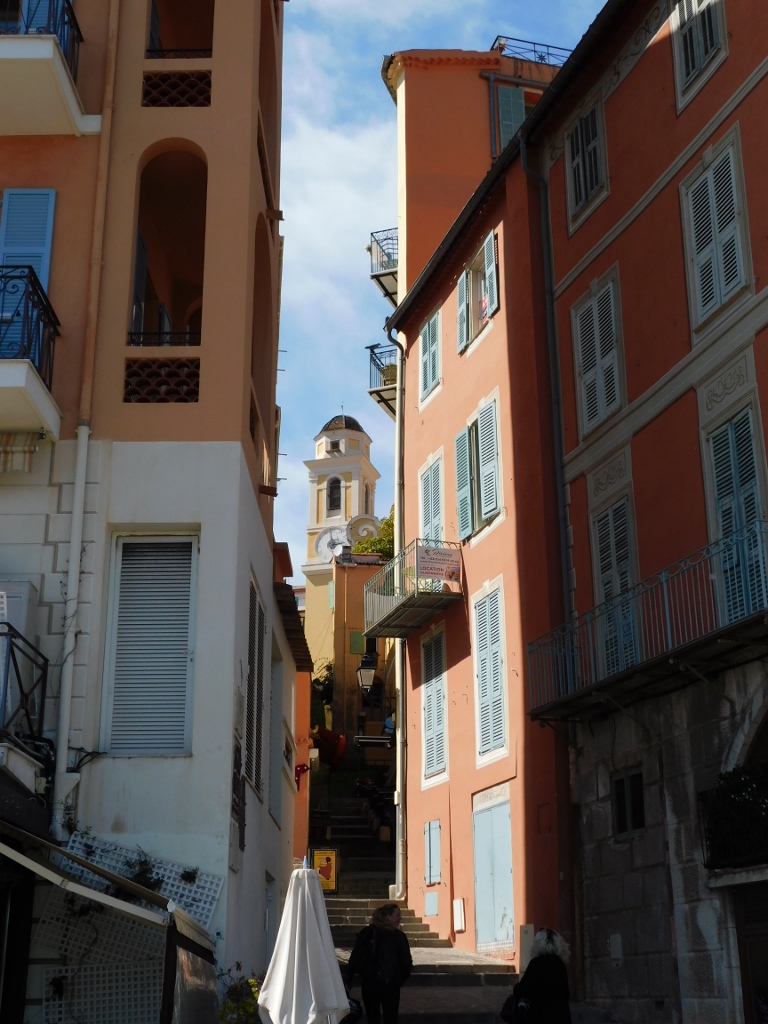 Villefranche-sur-Mer and the Church of Saint-Michel
Villefranche-sur-Mer and the Church of Saint-Michel
And then I continued with the stroll following the shore of the bay.
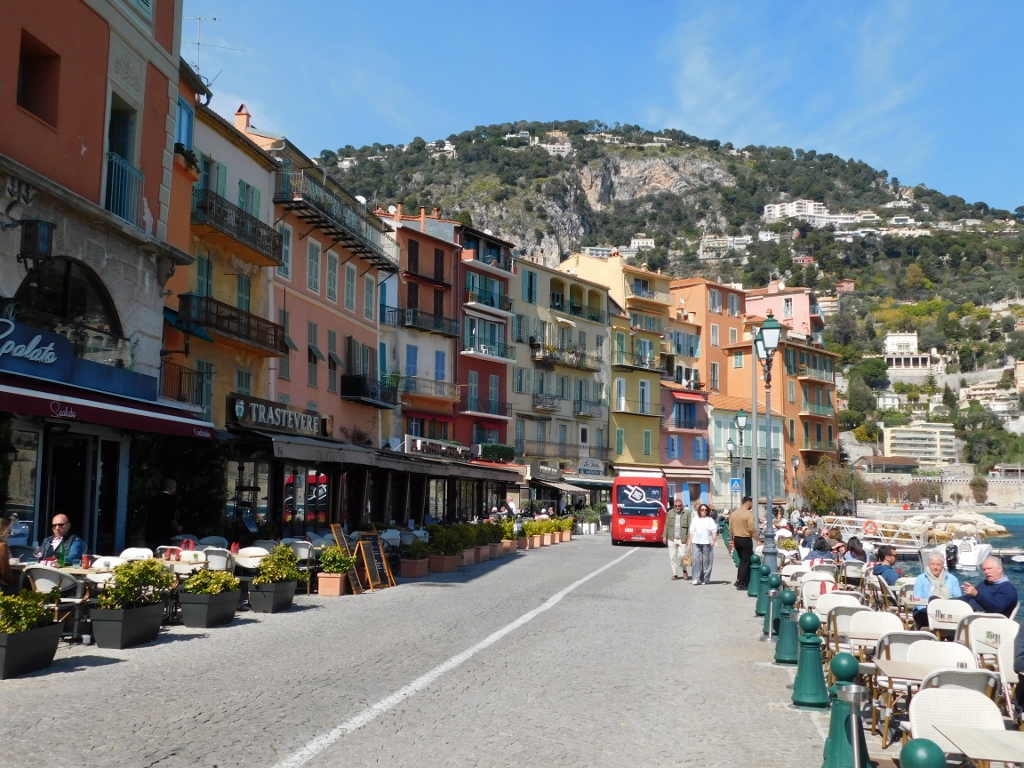 Villefranche-sur-Mer, a detail
Villefranche-sur-Mer, a detail
 Villefranche-sur-Mer bay
Villefranche-sur-Mer bay
When I got to the beach I could see that there were some brave swimmers who ventured into the water. Some others were merely looking at it or were getting out...
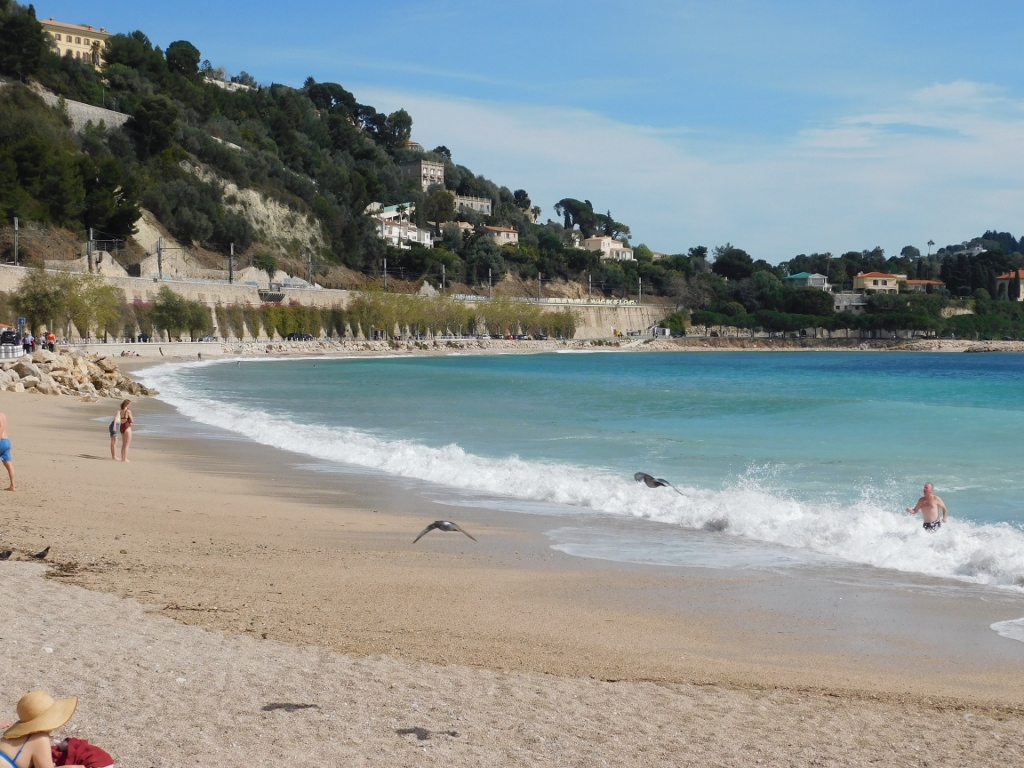 Villefranche-sur-Mer beach
Villefranche-sur-Mer beach
I practically made a semi-circle walking by the shore, since now I wanted to go to the peninsula of Saint-Jean-Cap-Ferrat located on the other side of the bay in relation to Villefranche-sur-Mer.
 Villefranche-sur-Mer is to the right, while Saint-Jean-Cap-Ferrat is to the left
Villefranche-sur-Mer is to the right, while Saint-Jean-Cap-Ferrat is to the left
By the time I climbed the peninsula using different paths and streets, it became a little cloudy. And yet, this did not prevent me from taking a nice photo of myself.
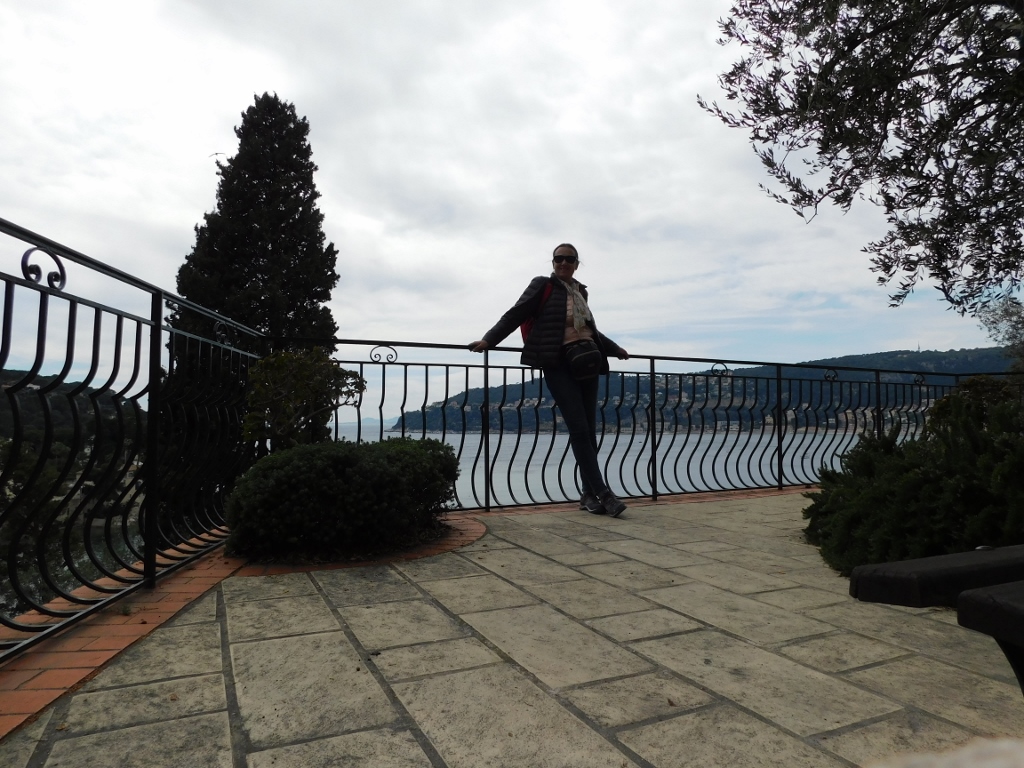 Self-portrait of sorts on Saint-Jean-Cap-Ferrat
Self-portrait of sorts on Saint-Jean-Cap-Ferrat
The main reason why I came here was to go to the Villa Ephrussi de Rothschild that is situated on this peninsula. I have already mentioned earlier (https://www.svudapodji.com/en/french-riviera-4/) that I planned to come here from the town of Beaulieu-sur-Mer that is located on the shore on the other side of the peninsula, but when I was there I did not have the time and had to give up the idea. Meanwhile I realised that it was easier to get to the villa from the town of Villefranche-sur-Mer.
I have already mentioned before that according to some estimates, the peninsula of Saint-Jean-Cap-Ferrat is considered the second most expensive residential location in the world after Monaco.
The situation was probably similar at the beginning of the 20th century as well and thus on a large estate of around 7 ha a mansion called Villa Ephrussi de Rothschild was built from 1907 till 1912. It is clear from the name of the villa that it belonged to somebody from the famous rich family. The person in question was concretely Béatrice Ephrussi de Rothschild (1864-1934).
The Rothschild banking dynasty was founded by Mayer Amschel Rothschild (1744-1812), a banker from Frankfurt, Germany. He had five sons – one of them remained in Frankfurt, while the other four were sent around Europe (London, Paris, Naples and Vienna) in order to continue to develop the business there. Not only were all of the sons under the strong influence of the father both as regards the selection of the profession and as regards the overall obedience, the Rothschild family is also known for the endogamy, i.e., marriages among close relations aimed at preserving the huge wealth which they all obviously knew how to acquire. I find this disgusting, but the fact is that they succeeded in this.
The youngest son Jakob Mayer Rothschild, often called James, was given the task to go to Paris. By the way, both he and his brothers are often mentioned with the title of baron because they received the hereditary title from Francis I, the first Emperor of Austria, so the official name is Baron James Mayer de Rothschild.
His oldest son was Mayer Alphonse James Rothschild, whose daughter was Baroness Charlotte Béatrice de Rothschild and so I come back to the story about the villa on the peninsula of Saint-Jean-Cap-Ferrat.
When the time came for Béatrice to be married, the Rothschild family was probably without potential candidates from among its own ranks, so the future son-in-law was selected from among “the rest.” As the girl came from an ultra-rich family it was difficult to find somebody comparable. But, they eventually did find Maurice Ephrussi who was, of course, not as rich as the Rothschilds (nobody was as rich as they were), but he was rich enough. In addition, he originated from Odessa (a part of the Russian Empire at the time) and had excellent connections in that part of the world which was most suitable for his future father-in-law. And so the deal, sorry, the marriage took place in 1883.
As is often proper among the extremely wealthy, Béatrice soon caught syphilis from her husband and could not have any children. In addition, although she herself loved to gamble, her husband was way ahead in this area and so in 1904 his gambling debts were at the level of today’s 30 million euros! The Rothschild family finally had to intervene (the health and the children are not that important, but money certainly is), so they asked for a separation through a court, which they eventually got.
And now I finally move to the story about the villa itself. When Baroness Ephrussi de Rothschild visited the French Riviera at the beginning of the 20th century, she visited Villa Kerylos (see: https://www.svudapodji.com/en/french-riviera-4/) that belonged to a relative of her husband. She fell in love with this area and bought an estate just a few kilometres farther where she had a large house built inspired precisely by the beauty of Villa Kerylos.
When the baroness died in 1934, she left the estate, the villa and her collections to the learned society of the Académie des Beaux Arts, a part of the Institut de France, in order for the villa to be used as a museum. Well, this was what I wanted to see.
At the entrance to the estate, one can still see the “guard’s house” which is in line with the size, importance and value of the property.
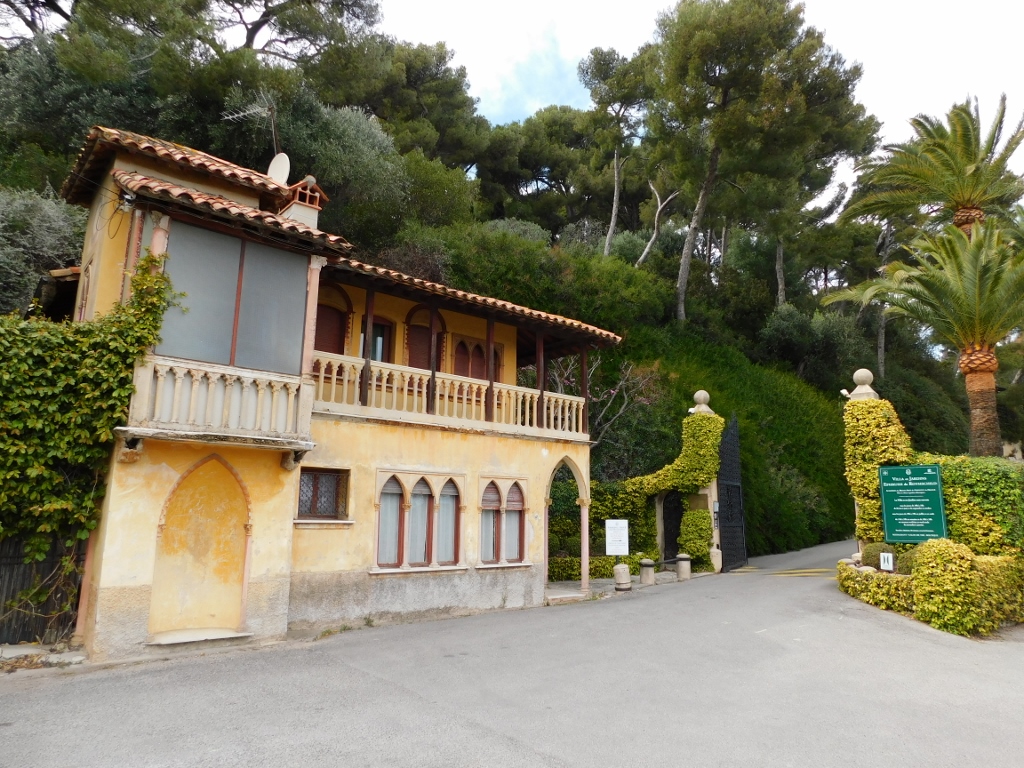 “Guard’s house” of the Villa Ephrussi de Rothschild
“Guard’s house” of the Villa Ephrussi de Rothschild
As I was going up the access road where the visitors may park their cars, I also looked at the surroundings.
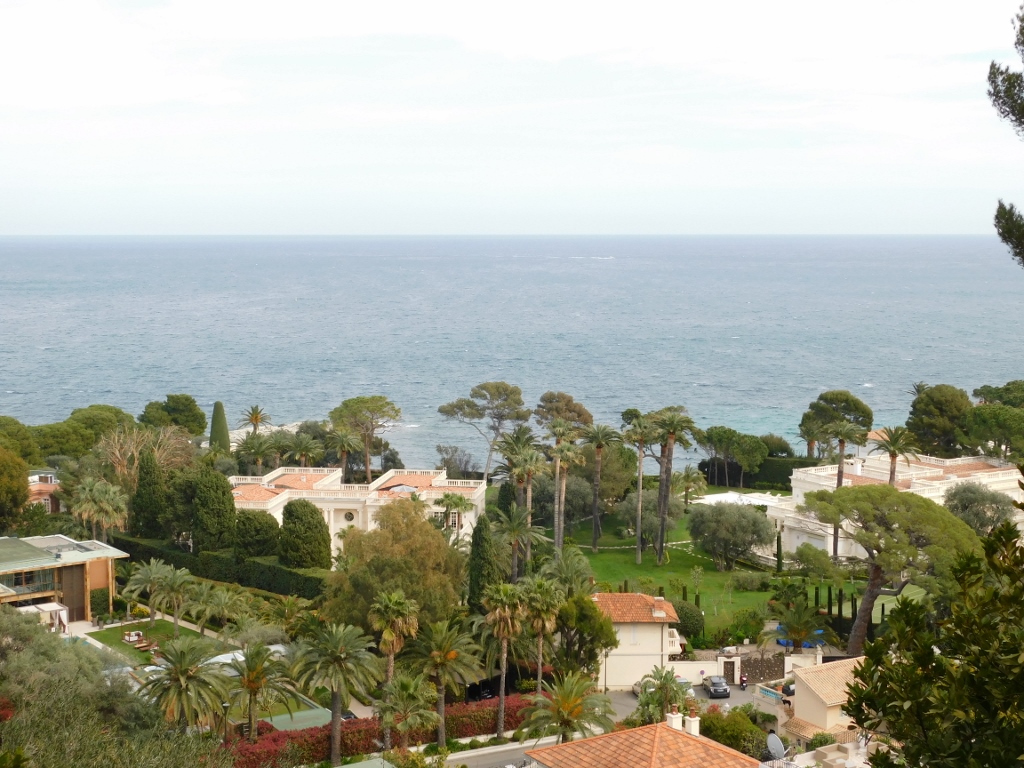 View from the access road of the Villa Ephrussi de Rothschild
View from the access road of the Villa Ephrussi de Rothschild
Then I bought the ticket and soon I was in front of the villa.
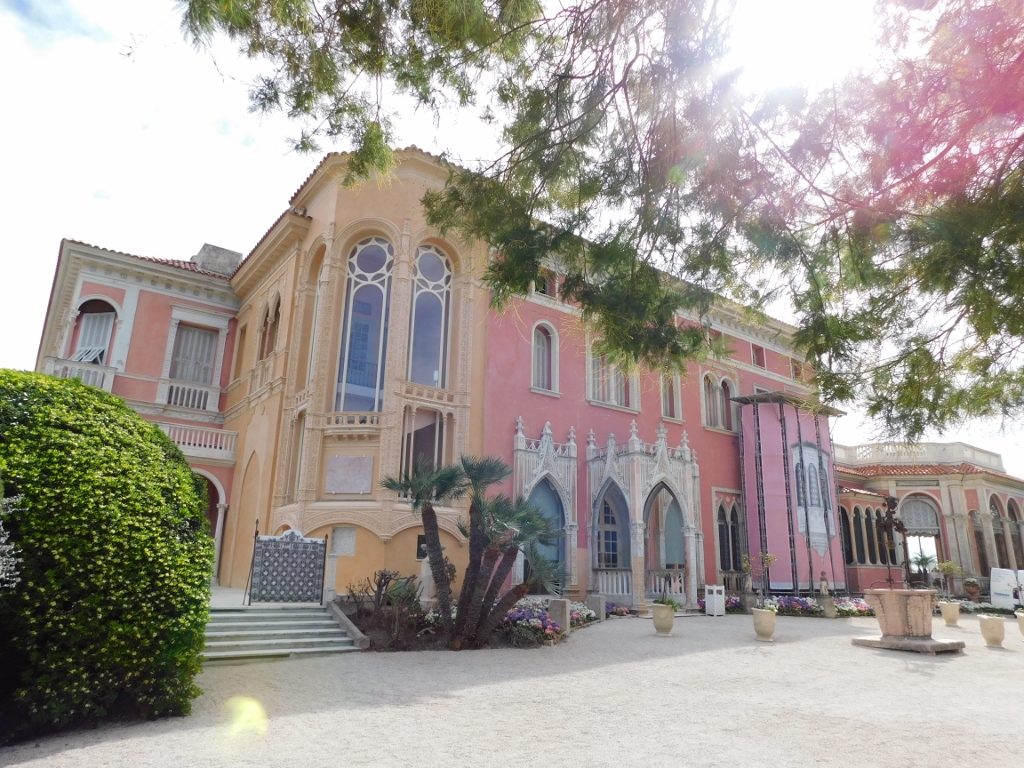 Front side of the Villa Ephrussi de Rothschild
Front side of the Villa Ephrussi de Rothschild
The villa is certainly beautiful, but what caught most of my attention here were the flowers on both side of the wide plateau in front of the villa.
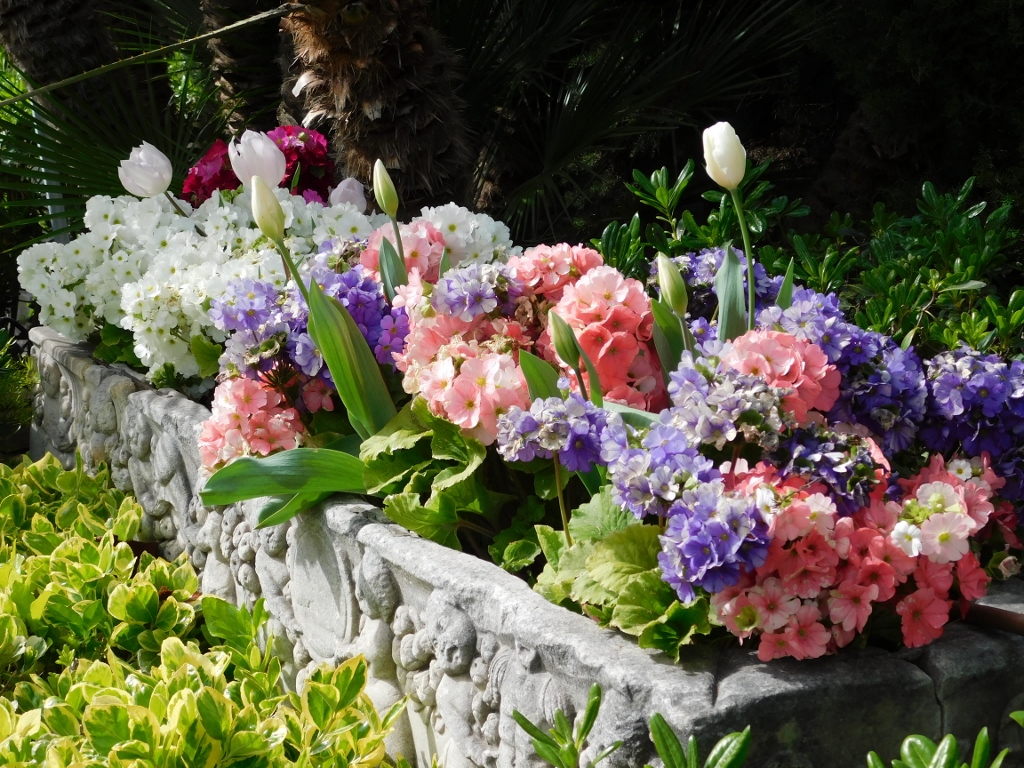 Flowers in front of the Villa Ephrussi de Rothschild
Flowers in front of the Villa Ephrussi de Rothschild
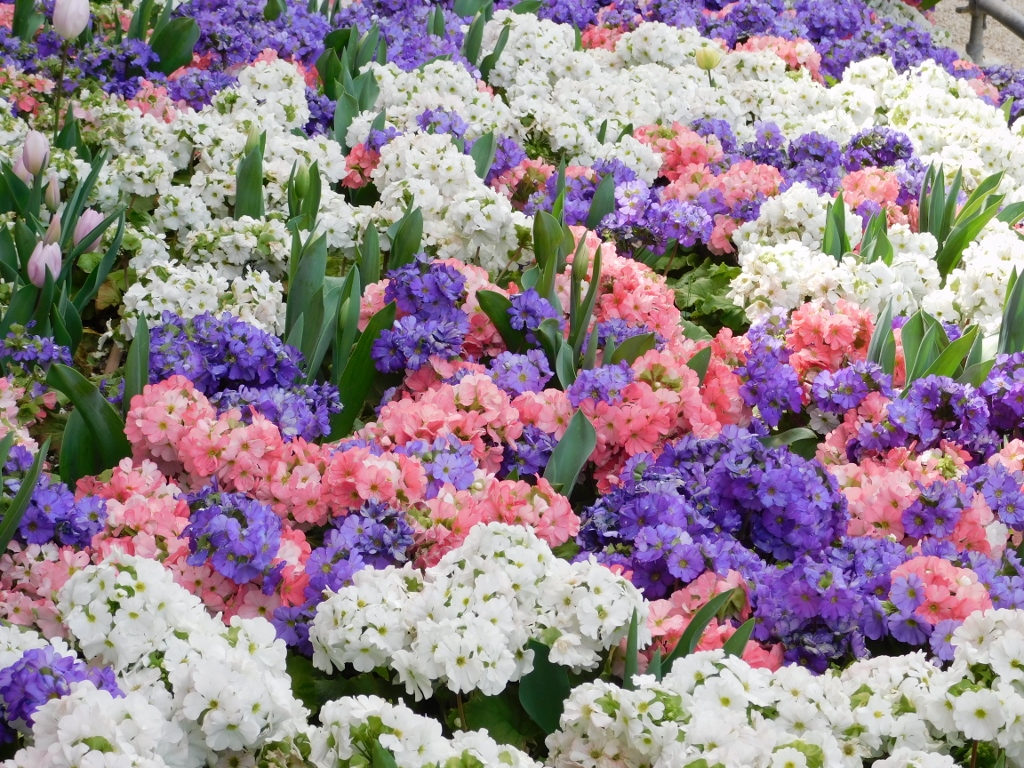 Flowers in front of the Villa Ephrussi de Rothschild
Flowers in front of the Villa Ephrussi de Rothschild
At the entrance, I got an audio-guide and so I started with my walk around the villa.
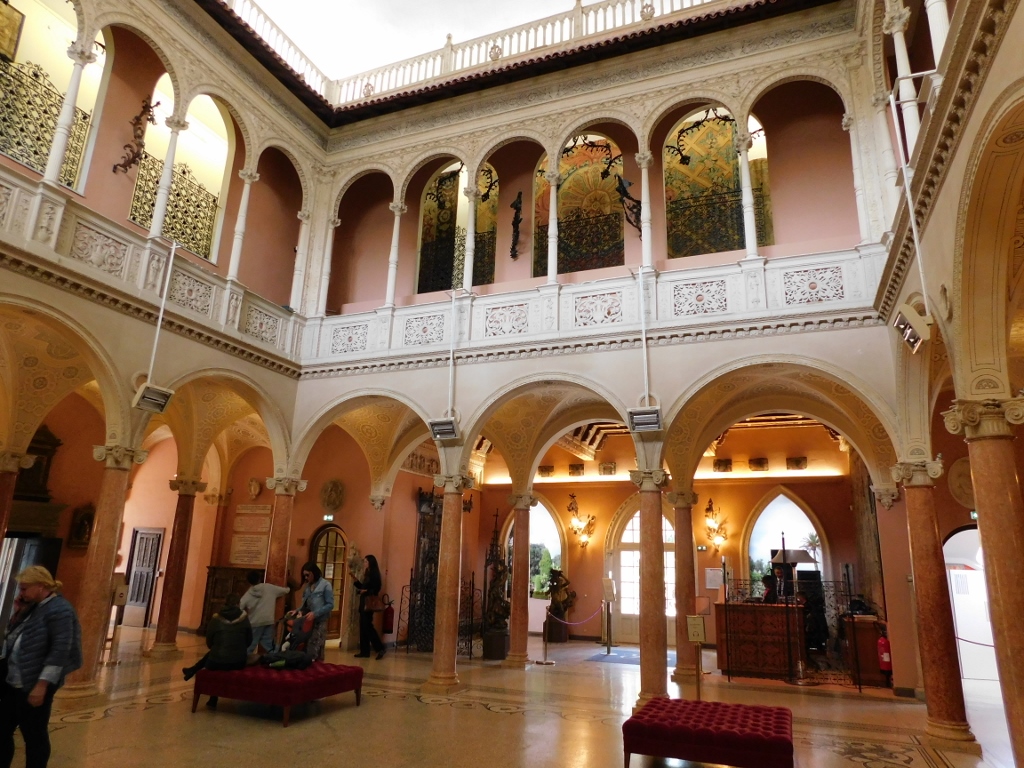 Villa Ephrussi de Rothschild, a detail
Villa Ephrussi de Rothschild, a detail
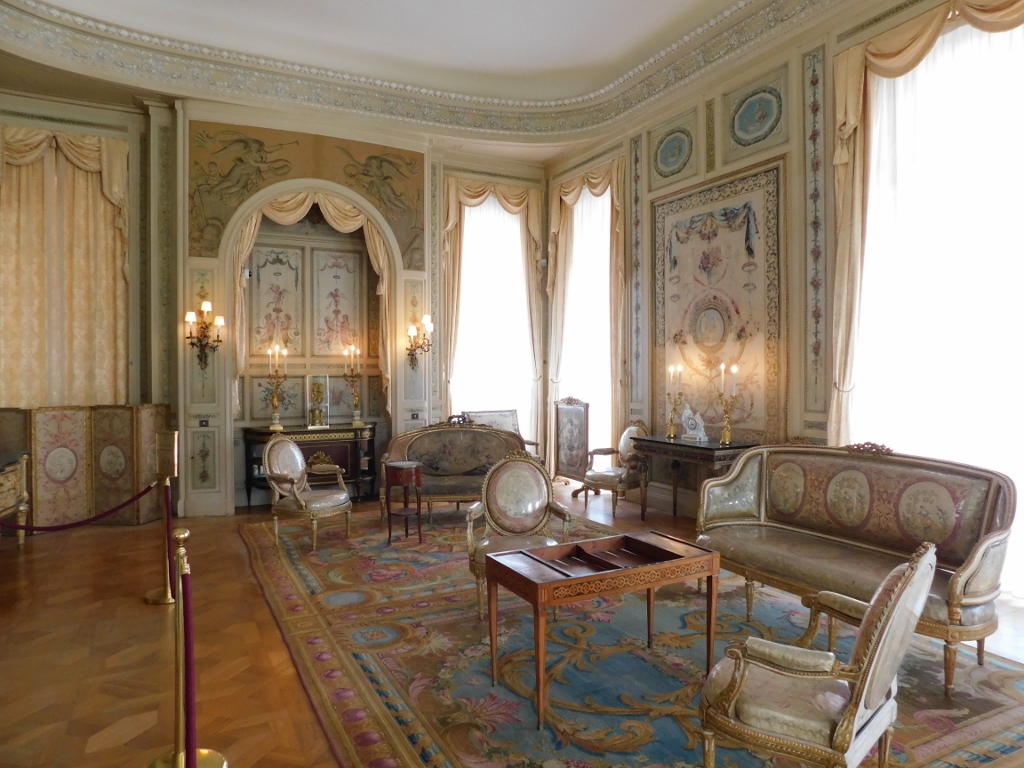 Villa Ephrussi de Rothschild, a detail
Villa Ephrussi de Rothschild, a detail
The audio-guide, as well as different texts that I have read about Baroness Ephrussi de Rothschild emphasise quite a lot that the baroness had an exquisite taste for arts, decoration, etc. According to my taste, this is simply overemphasised. As the fourth generation, I guess she should have already been a part of the “old money” and not the first generation of some nouveau riche family, with everything that such division may entail. But, I found this over-the-top emphasis in poor taste and could not help but think that in her case it could just suffice that she had practically limitless funds at her disposal – it would be enough for her to show up at an auction and buy whatever was the most expensive. The others would have already done the quality assurance of whatever was being sold.
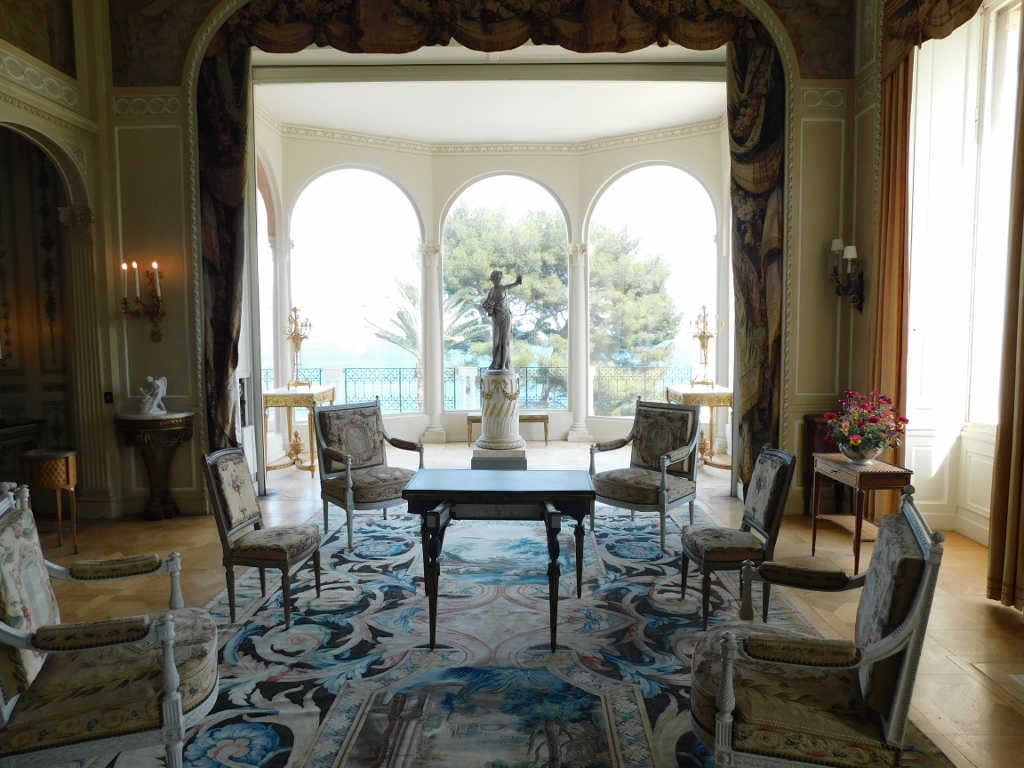 Villa Ephrussi de Rothschild, a detail
Villa Ephrussi de Rothschild, a detail
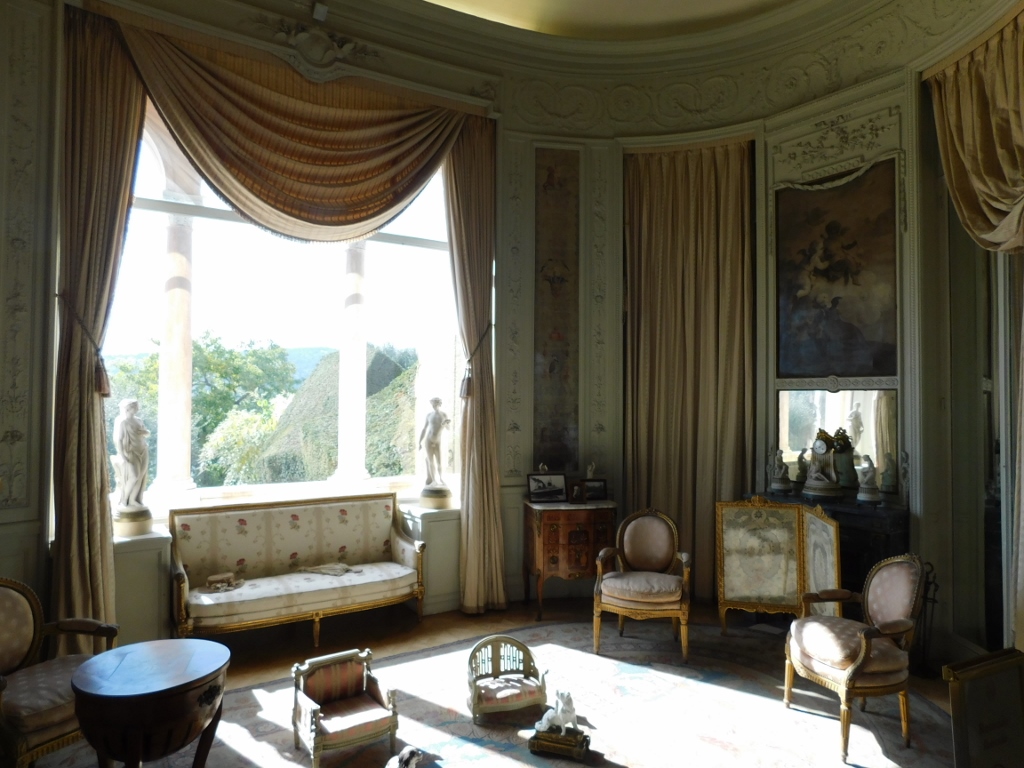 Villa Ephrussi de Rothschild, a detail
Villa Ephrussi de Rothschild, a detail
On the other hand, when I was in the room seen in the photo above, the audio-guide additionally shared the story about the dogs of Baroness Ephrussi de Rothschild. You can notice two miniature “arm-chairs” in the photo and these were earmarked for the dogs. Namely, at her property she had different animals, but two tiny dogs were her favourites. So much so that she even organised their wedding – one dog was dressed in a suit and the other one in a dress, while the whole thing was followed by journalists and there were even newspaper articles in America about this. Using a soft voice, the audio-guide explained this as a probable substitute for the lack of children. I would explain this as pure decadence.
After all, one room of the villa is used as a kind of cinema showing a short documentary on the life on the French Riviera at the beginning and in the first half of the 20th century, including also WWI. It is important that WWI reached the French Riviera only in the shape of newspaper articles and wounded men (a very limited number) who recuperated here at one or two places. As for the rich people who either permanently lived here or occasionally spent some time at their properties and mingled with the like-positioned, the film showed that they had the blast without apparently a single care in this world or, heaven forbid, guilty conscience, organising car races, outings, parties, gambling, etc. Perhaps such life during difficult times makes an impression on people, after all it does make an impression on me, too, but in my case this is a very, very bad impression.
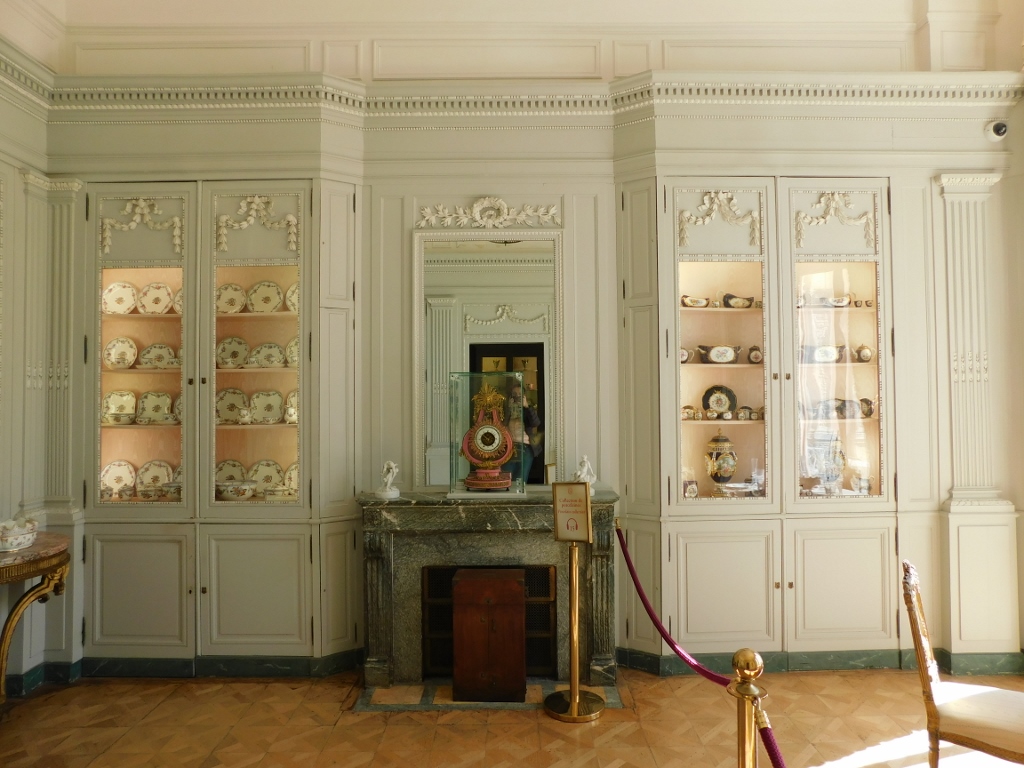 Villa Ephrussi de Rothschild, a detail
Villa Ephrussi de Rothschild, a detail
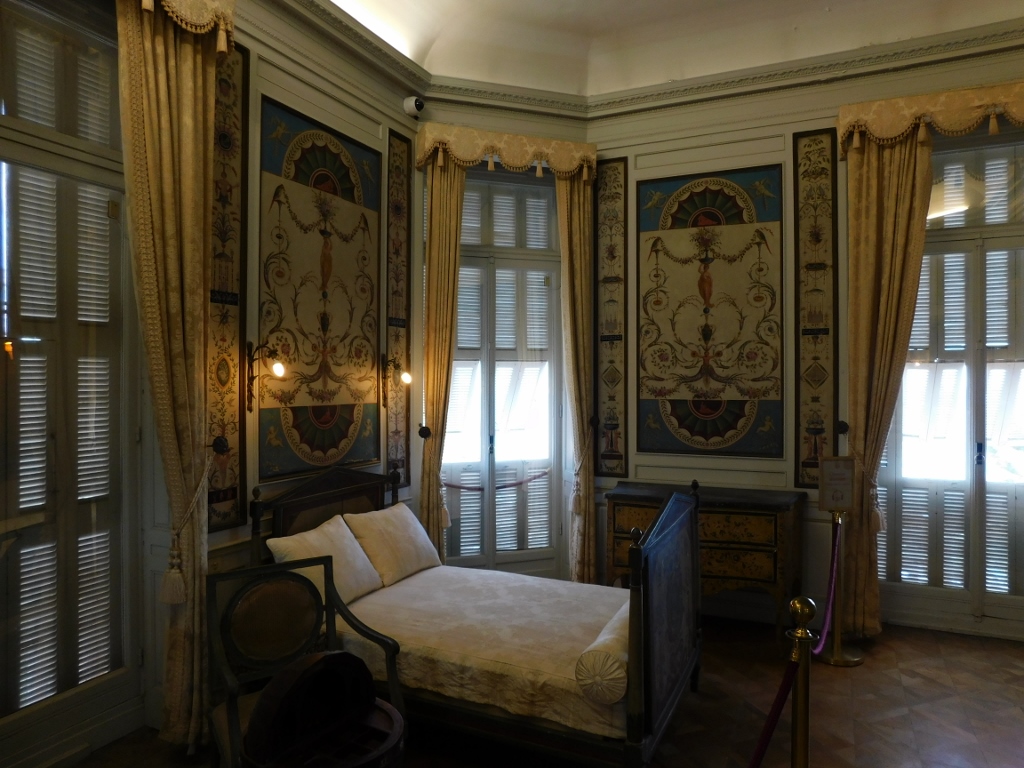 Villa Ephrussi de Rothschild, a detail
Villa Ephrussi de Rothschild, a detail
The photo below shows a table for some kind of game that certainly entailed gambling. I have already mentioned that the owners of the villa loved to gamble. Monaco is just a stone’s throw away and they must have visited other casinos along the coast as well. On the other hand, it would have been convenient to be able to entertain in this way at home, too.
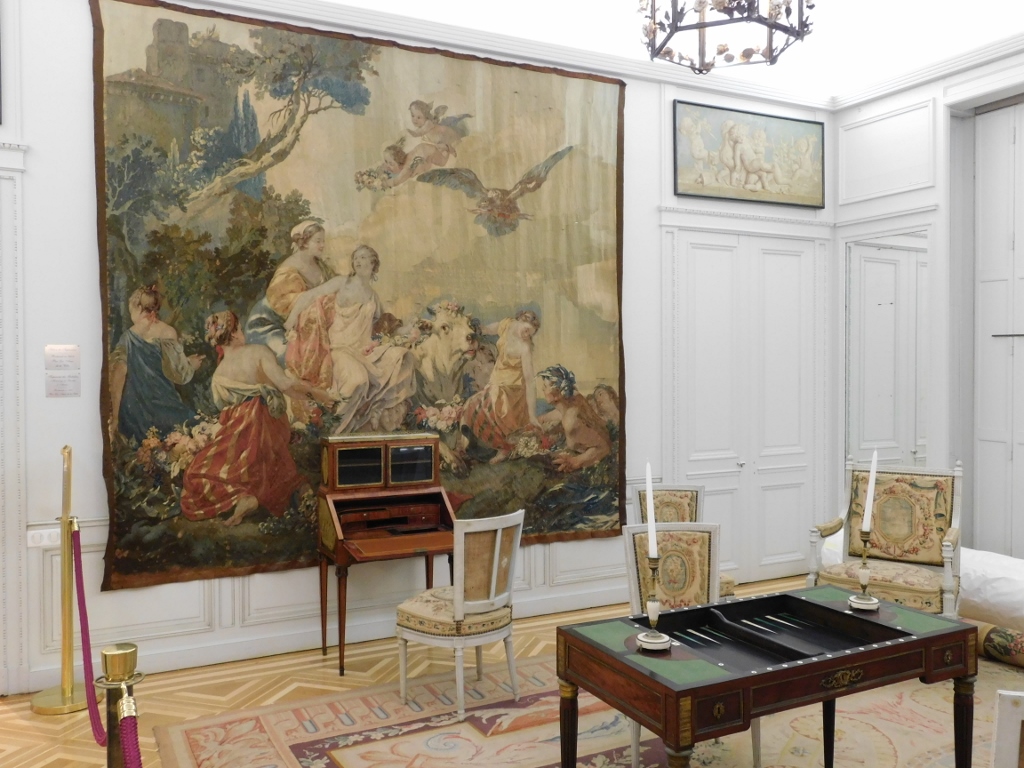 Villa Ephrussi de Rothschild, a detail
Villa Ephrussi de Rothschild, a detail
I must admit that my train of thought about the extreme decadence of the owners and their friends as well, so nothing personal here, led me to a point that I wanted to finish with my visit to the villa as soon as possible. I also thought about myself, wondering if I minded all of this simply because I could never have it myself. In other words, I asked myself if I was jealous.
It is quite clear that in every aspect a Rothschild baroness and I belong to completely different galaxies. She would never be friends with me, but I must admit that I’m sure I would never be friends with her. I can afford to be friends with whomever I feel like and not only with those who are of a similar financial status as I and I choose people in my life according to their quality and not their bank account. In this respect, I’m incomparably wealthier than what the given baroness ever was.
Here I can be assisted by George Mikes, a brilliant Hungarian-British journalist and humorist who in one of his pieces mentioned that the rich people often complain because the others love them “for their money.”
As George Mikes says, and here I’m paraphrasing, such a position of rich people is wrong for two reasons. The first one is that, by the rule, they are so unlikeable that they should be happy that anybody loves them for any reason whatsoever. The other reason is that nobody can love somebody for their money; a person may love money and bear the one that goes along with it, but they can never love somebody because of the money.
What I wanted to do here was to get out of the villa and to start with my visit to the large gardens that take up most of the property. But, beforehand, from the upper floor, through a window, I could see the Villa Kerylos in Beaulieu-sur-Mer that was the inspiration for the construction of the villa that I was currently in.
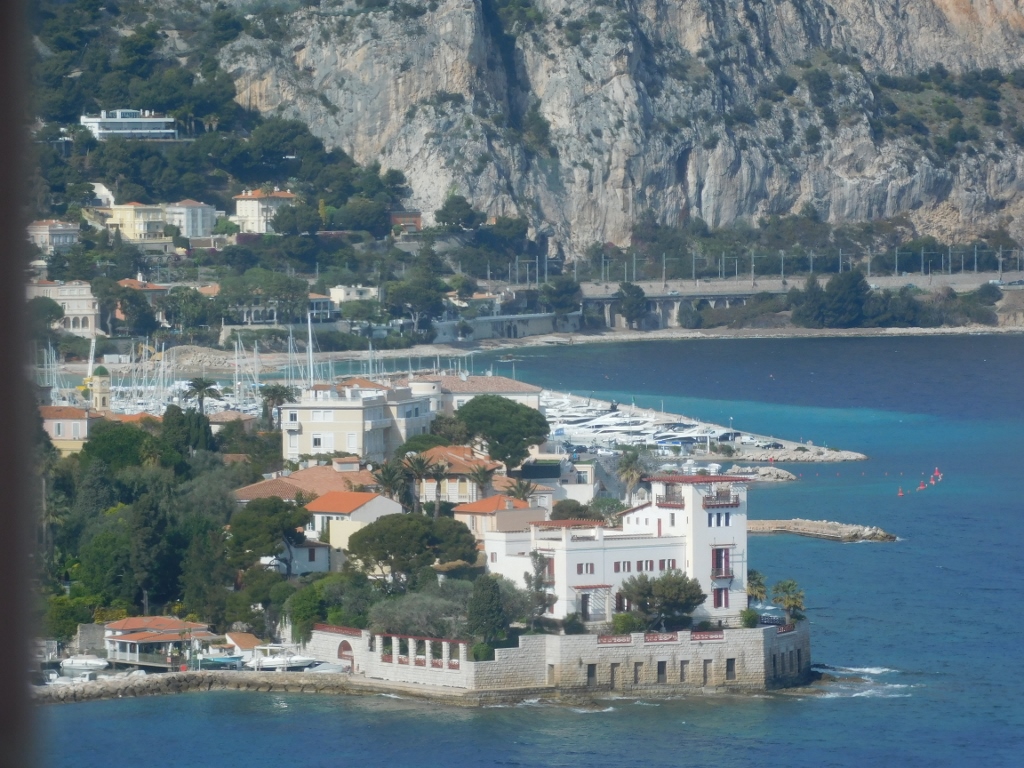 View at the Villa Kerylos in Beaulieu
View at the Villa Kerylos in Beaulieu
From the upper floor, there is also a very pretty view at a part of the gardens with a pool and a fountain.
 The Villa Ephrussi de Rothschild Gardens
The Villa Ephrussi de Rothschild Gardens
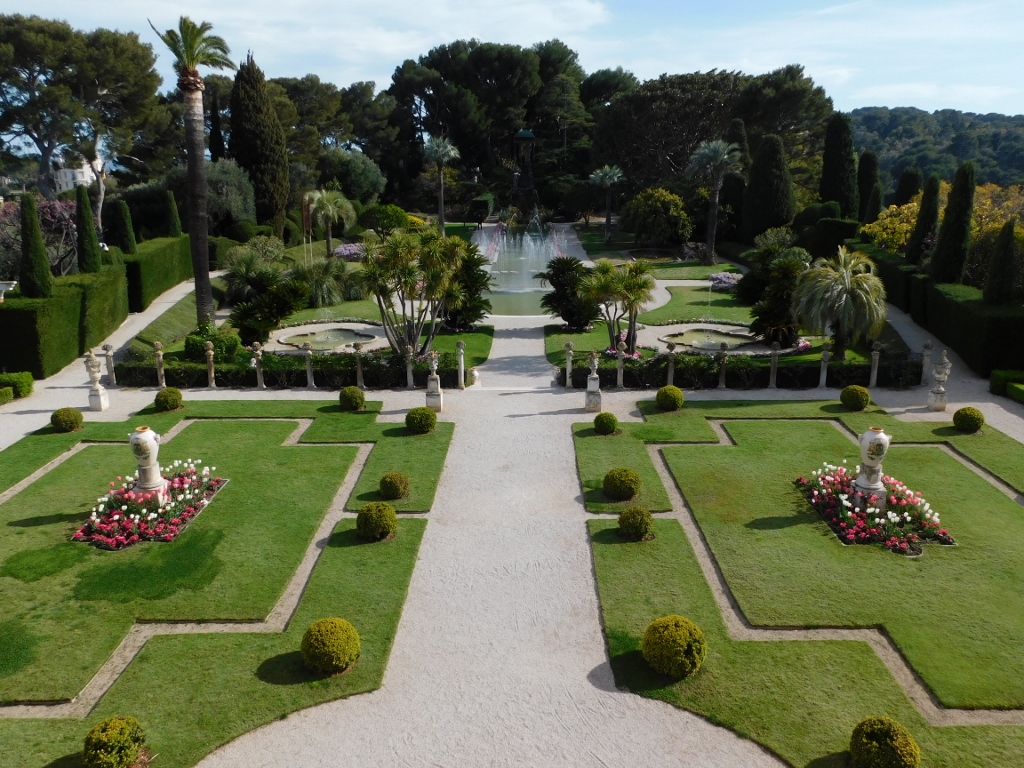 The Villa Ephrussi de Rothschild Gardens, a detail
The Villa Ephrussi de Rothschild Gardens, a detail